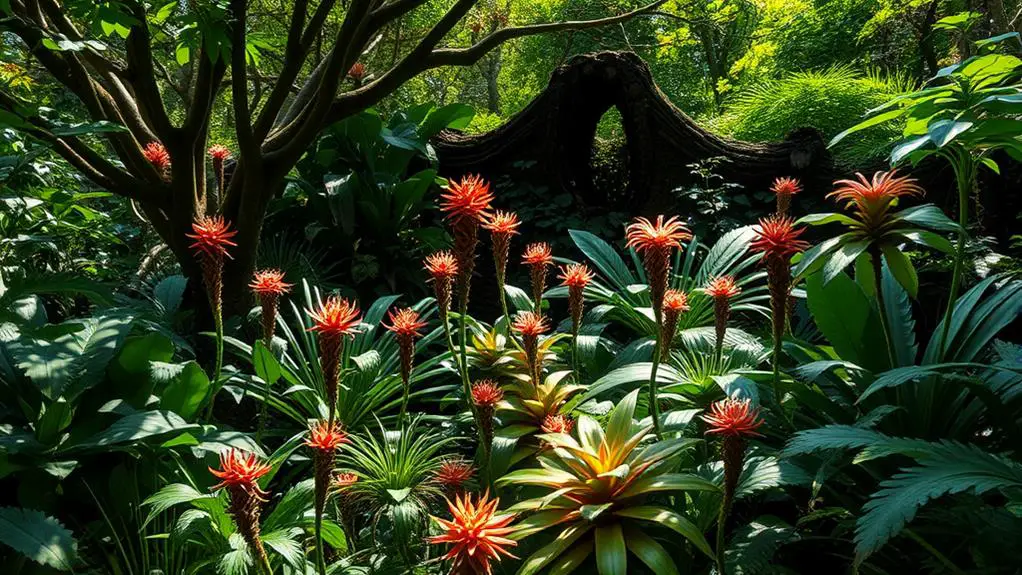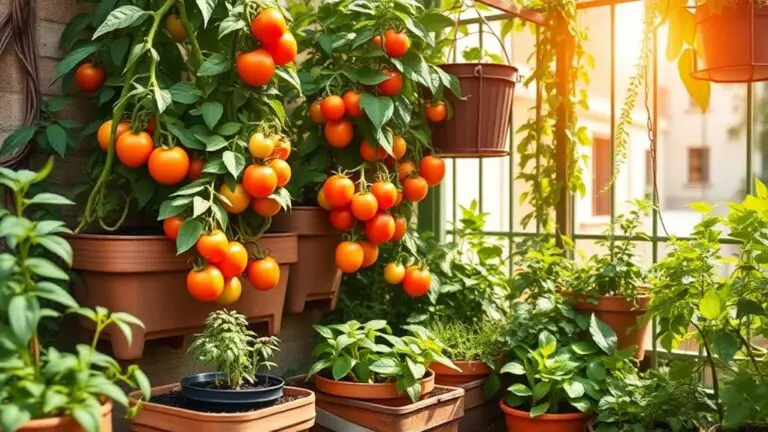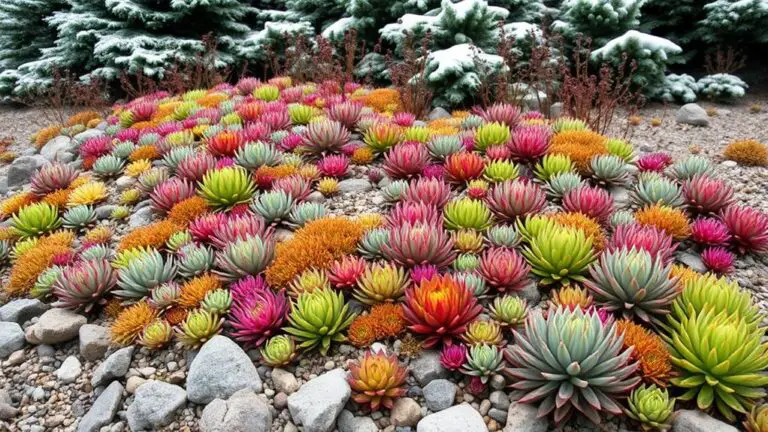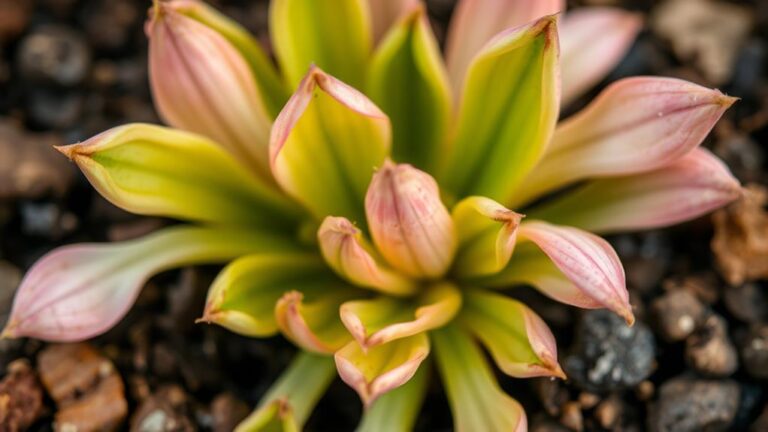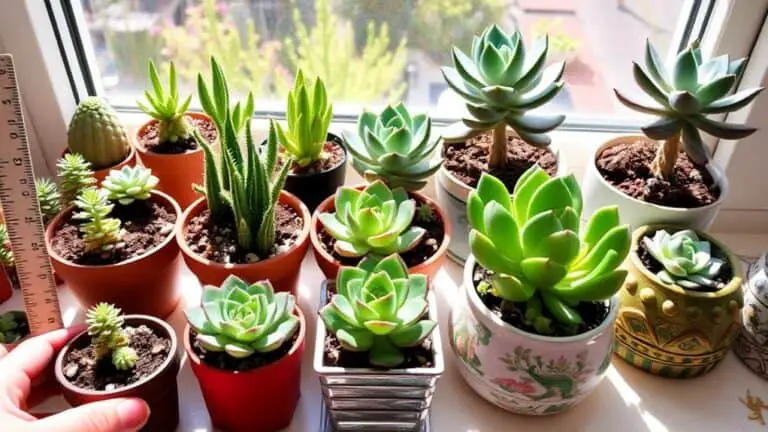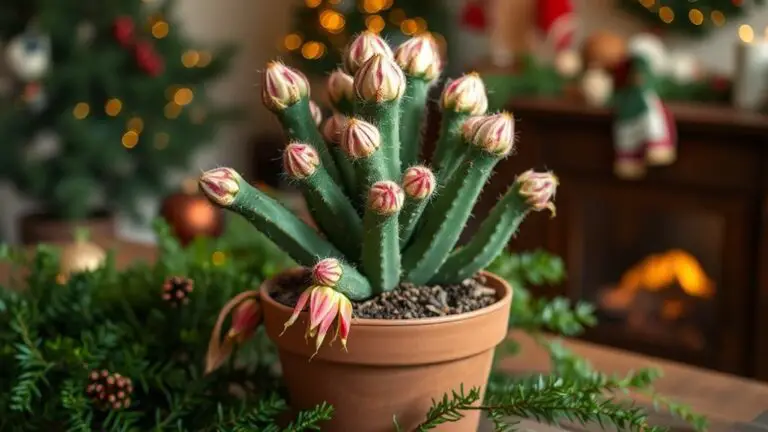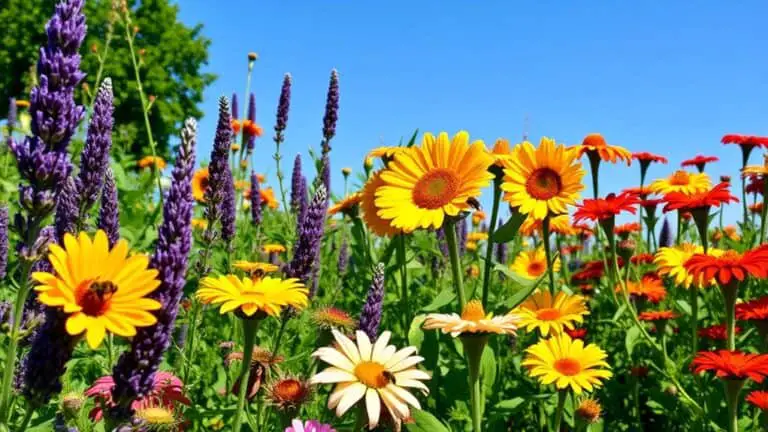9 Incredibly Difficult Plants for Expert Gardeners to Grow
If you're an expert gardener looking to challenge your skills, you'll find nine plants that truly test your expertise. From the precise soil conditions needed for Bearded Iris and Peony, to the specific humidity and pH levels required by Gardenia and Alocasia, these plants aren't for the faint-hearted. Trillium and Azalea add to the complexity with their need for vigilant pest and environmental monitoring. Tackling these demanding varieties means committing to advanced techniques and long-term care. Ready to elevate your gardening game? Let's explore what makes these plants so notoriously difficult to cultivate.
Bearded Iris
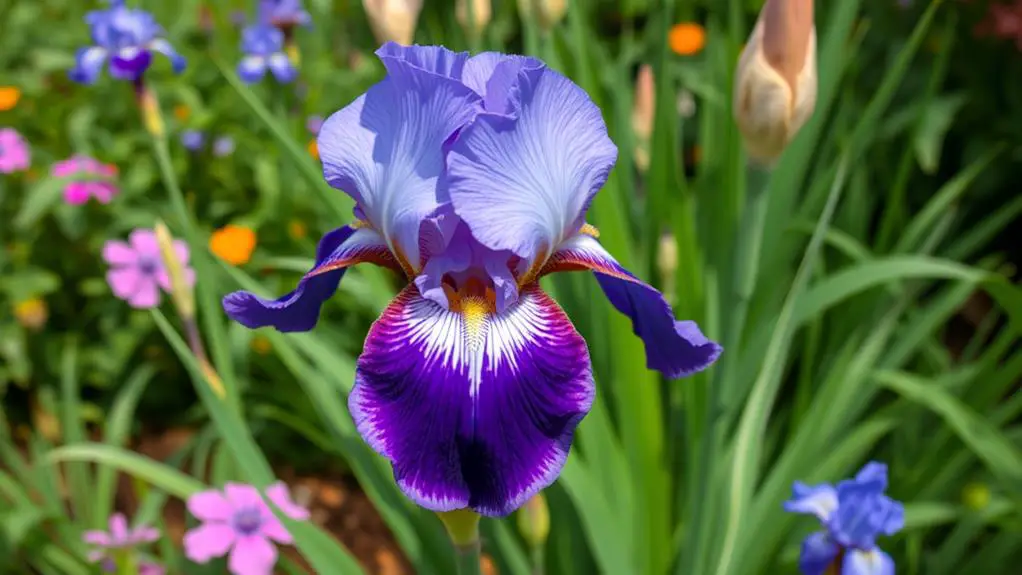
Bearded Iris is a rewarding yet challenging plant that requires careful attention to detail. If you're up for the task, you'll find that the effort is worth it.
To start, Bearded Iris can be difficult to grow because it needs well-drained soil to prevent root rot. Plant the rhizomes 1-2 inches below the surface to keep them from getting too wet. Full sun is another key to their success. Make certain they get plenty of light throughout the day.
Proper spacing is vital too. Place your Bearded Iris plants 15-18 inches apart. This helps reduce the risk of diseases like leaf spot and keeps pests like aphids at bay. Overcrowding can lead to poor blooming, so give each plant enough room to breathe.
Every three years, you'll need to divide the plants to maintain their vigor. This keeps them from becoming overcrowded and guarantees they continue to bloom beautifully.
Regular monitoring is also essential. Watch out for signs of diseases and pests, and take action quickly if you spot any problems. By following these steps, you'll increase your chances of successfully growing these stunning flowers.
Border Phlox
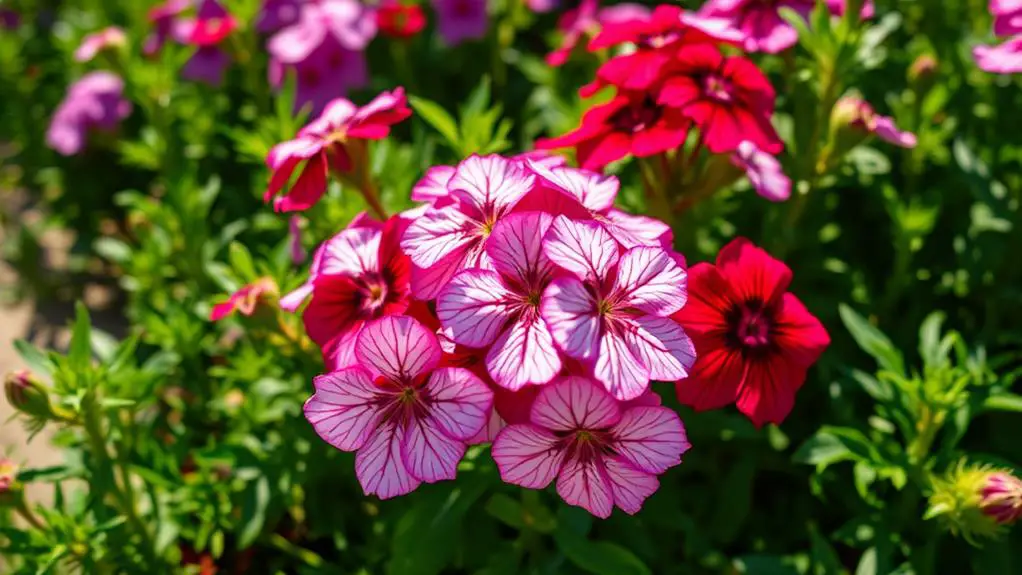
Although Border Phlox can be a stunning addition to any garden, it poses several challenges that even seasoned gardeners must carefully navigate. These flowering plants are known for their vibrant colors, which attract many pollinators. However, they are also prone to powdery mildew, a common fungal disease. Guaranteeing good air circulation is vital to prevent this, especially in overcrowded or shaded areas.
Maintaining adequate airflow and well-drained soil is fundamental to reducing the risk of spider mites, which can suffocate your plants. Newer cultivars of Border Phlox have been developed with better disease resistance, making them more suitable if you're concerned about common ailments. These perennials thrive in full sun to partial shade and prefer well-drained, fertile soil, emphasizing the importance of the right growing conditions for peak blooming.
| Challenge | Solution |
|---|---|
| Powdery Mildew | Guarantee good air circulation |
| Spider Mites | Maintain well-drained soil |
| Disease Resistance | Choose newer cultivars |
High humidity can exacerbate these issues, so it's important to monitor the plant care closely. By following these guidelines, you can enjoy the beauty of Border Phlox in your garden while minimizing potential problems.
Black-Eyed Susan
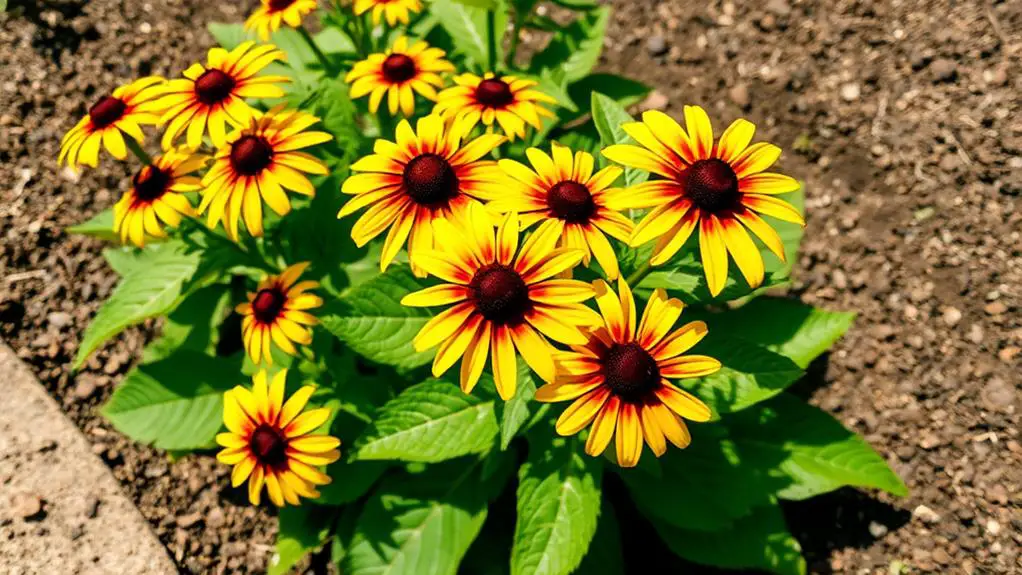
Black-Eyed Susans, with their striking golden petals and contrasting dark centers, are a vibrant and resilient addition to any garden. However, they do come with challenges. Black-Eyed Susans (Rudbeckia hirta) are prone to fungal diseases, like leaf spot, which can damage their beautiful foliage.
To combat these issues, make certain you plant them with at least 12-18 inches of space between each plant. This spacing guarantees good air circulation, which helps keep fungal diseases at bay.
These plants thrive in full sun and well-drained soil, so choose their location carefully. They don't need a lot of care once they're established, but they do benefit from occasional deadheading. This means removing old flowers to encourage new blooms, which can extend their flowering period.
Newer cultivars of Black-Eyed Susan have been bred for better disease resistance, so you might want to take into account these varieties for a healthier garden. Not only do these plants add a pop of color, but they also attract pollinators like bees and butterflies.
This makes them a valuable addition to naturalistic and prairie-style gardens, contributing to a healthier ecosystem.
Dahlia
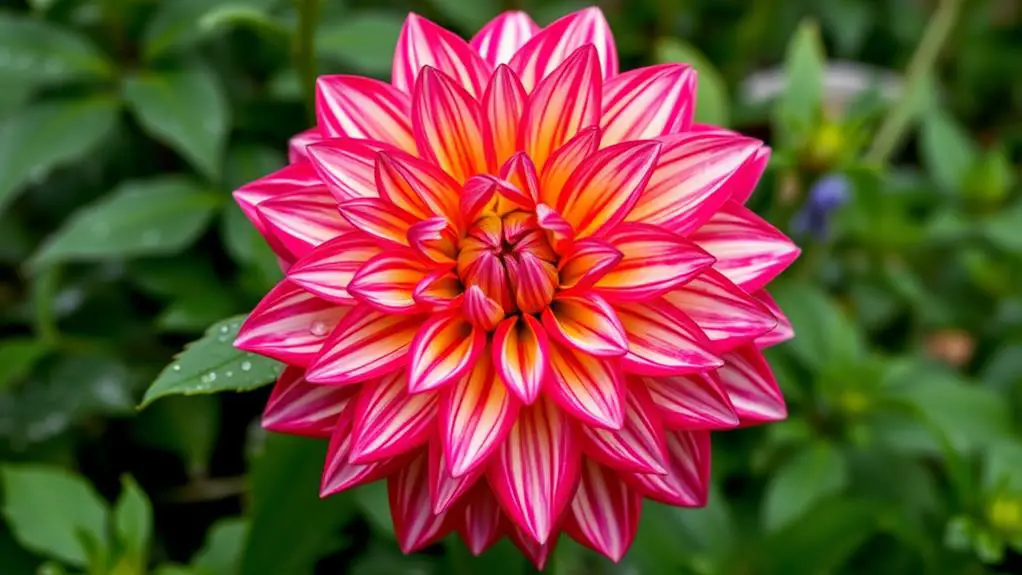
When growing dahlias, you'll need to wait until the soil warms up to at least 60°F before planting to guarantee they thrive.
Be careful with watering, as dahlias need well-drained soil to prevent tuber rot, making overwatering a common mistake.
For taller varieties, remember to stake them to support those heavy blooms and keep the branches from breaking.
Planting Timing and Depth
Timing and depth are vital when planting dahlias to guarantee they thrive. You should plant dahlias after the last frost date because they need warm soil temperatures, around 60°F (15°C) or higher. This planting timing secures your dahlias have the best growing conditions. The type of soil is also essential. Make certain the soil is well-drained to prevent waterlogging, which can cause the tubers to rot.
When you plant, dig a hole about 6-8 inches deep. This depth helps the tubers settle well and grow strong roots. Additionally, pick a spot that gets full sun for at least 6-8 hours a day. This sunlight is necessary for your plant to grow healthy and bloom abundantly.
Space the dahlia tubers 12-18 inches apart. This spacing allows for good air circulation and helps reduce the risk of fungal diseases. After planting, water generously but be careful not to over-saturate the soil later on.
Here's a quick reference table to help you:
| Factor | Recommendation | Reason |
|---|---|---|
| Planting Timing | After last frost date | Warm soil needed |
| Soil Type | Well-drained | Prevents rot |
| Planting Depth | 6-8 inches | Strong root growth |
| Sunlight | Full sun (6-8 hours) | Healthy growth and blooming |
| Spacing | 12-18 inches apart | Air circulation, disease prevention |
Watering and Soil Requirements
Once you've got the timing and depth right, focus on watering and soil requirements for dahlias to guarantee they flourish. Proper watering is essential. After planting, water your dahlias well.
Then, monitor the soil closely. Overwatering can cause tuber rot, so you want to keep the soil moist but not waterlogged. Aim for soil that's consistently moist during the growing season, especially in dry spells.
Dahlias thrive in well-drained soil that's rich in organic matter. You should plant them in soil with a pH level between 6.0 and 7.0. This guarantees they get the nutrients they need for healthy growth and vibrant blooms.
Here's a quick checklist to help you:
- Ensure warm soil: Plant dahlias when soil temperatures reach at least 60°F.
- Monitor moisture: Water thoroughly after planting, but avoid waterlogging.
- Use rich, well-drained soil: Incorporate plenty of organic matter.
- Maintain pH levels: Keep soil pH between 6.0 and 7.0.
With these steps, your dahlias will have the best chance to thrive. Remember, the right balance of moisture and rich soil is key to growing these beautiful, yet challenging, flowers.
Support and Staking Needs**
Supporting your dahlias is essential to affirm their heavy blooms don't cause the stems to break, especially during windy conditions or heavy rains. To achieve this, you'll need to stake your plants properly. Dahlias, particularly the taller varieties, often require staking to keep their branches from breaking.
Start by choosing sturdy stakes that are at least 1-2 feet taller than your plants. This affirms they'll provide adequate support throughout the growing season. It's best to stake your dahlias early in the growing process, ideally before they reach 12 inches in height. Doing this early prevents you from disturbing the roots later on, which can be a delicate task.
Besides vertical stakes, some gardeners prefer using circular supports or cages. These provide additional stability and help keep your plants from flopping over.
As your dahlias grow, regularly check and adjust the stakes. This affirms they remain properly supported and aren't constricted as they develop.
Peony
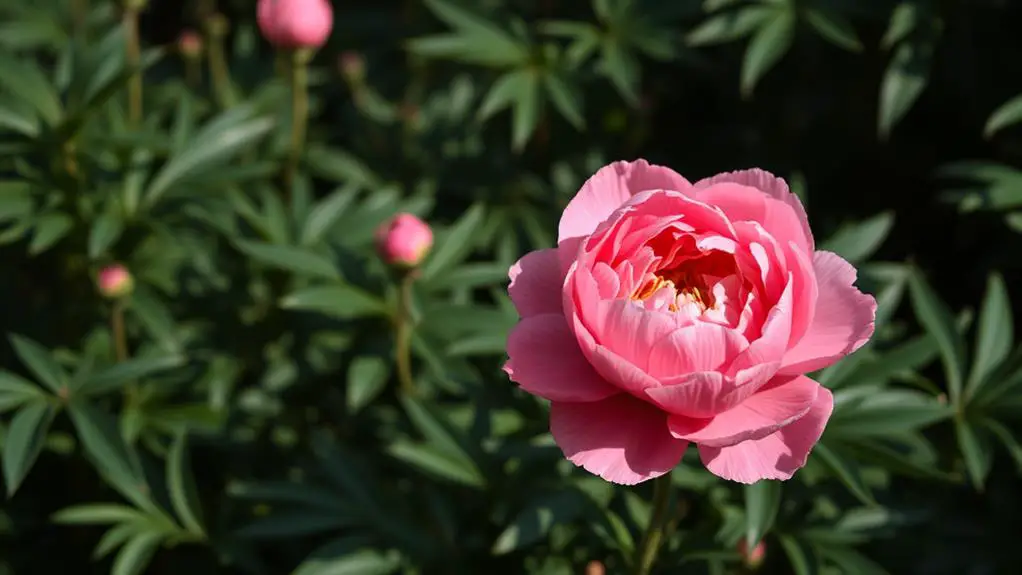
When planting peonies, make sure you place the buds no more than 2 inches below the soil surface, as deeper planting can prevent blooming.
Peonies love full sunlight, so pick a spot where they'll get at least six hours of sun each day.
Keep an eye out for common pests like aphids and thrips, and use natural remedies or insecticidal soap to keep them at bay.
Planting Depth Guidelines
Planting peonies correctly is vital for their health and bloom production, and getting the depth right is a significant step. To guarantee proper growth, you need to plant peonies with their eyes (buds) positioned 1-2 inches below the soil surface. This depth is essential, as planting too deep can hinder flowering.
Peonies require a cold dormancy period to thrive and bloom effectively.
It's also important to plant peonies in well-drained soil to prevent root rot. Waterlogged soil can damage their roots and overall health.
Giving your peonies plenty of space is another key factor. They should be spaced at least 3 feet apart to allow for ideal air circulation and avoid overcrowding.
Here are some tips to remember:
- Planting Depth: Guarantee the eyes (buds) are 1-2 inches below the soil surface.
- Well-Drained Soil: Avoid waterlogged conditions to prevent root rot.
- Ideal Air Circulation: Space plants at least 3 feet apart.
- Proper Growth: Consider that peonies take several years to settle and produce blooms.
Sunlight Requirements
Peonies' sunlight needs are essential for their vibrant growth and abundant blooms. To thrive, peonies require full sun, meaning they need at least 6-8 hours of direct sunlight daily. Ensuring they get this amount of light is key to promoting robust growth and plentiful flowering.
When selecting a planting location, choose a spot in your garden that receives ample sunlight throughout the day. This helps peonies develop their large, heavy blooms, which often need staking to support their weight. If peonies don't get enough sunlight, they may have weak stems and reduced blooms, making it vital to position them in well-lit areas.
Here's a quick guide to help you understand peonies' sunlight requirements:
| Sunlight Requirement | Impact on Peonies | Tips for Gardeners |
|---|---|---|
| Full Sun (6-8 hours) | Best growth and flowering | Choose a sunny spot |
| Partial Shade | Reduced blooms, weaker stems | Use only in hot climates |
| Inadequate Sunlight | Poor growth, minimal flowers | Avoid shaded areas |
Pest Control Measures
Making sure peonies get the right amount of sunlight is just one aspect of their care; another vital factor is managing pests that can threaten their health. Peonies are particularly vulnerable to pests like ants and aphids. Ants can actually protect aphids, making it essential to monitor for these pests regularly.
To tackle aphid infestations, you can introduce beneficial insects like ladybugs, which naturally prey on aphids. Alternatively, using insecticidal soap is a great treatment option. This soap helps eliminate aphids without harming the plant.
Fungal diseases, such as botrytis blight, can also affect peonies. To prevent these diseases, guarantee good air circulation around your plants and maintain proper spacing between them. This helps keep the foliage dry, reducing the risk of fungal infections.
Here are some key pest control measures for peonies:
- Introduce beneficial insects, such as ladybugs, to tackle aphids.
- Use insecticidal soap to treat aphid infestations.
- Guarantee good air circulation and proper spacing to prevent fungal diseases.
- Regularly inspect foliage for beetles and caterpillars, and handpick them if necessary.
Trillium
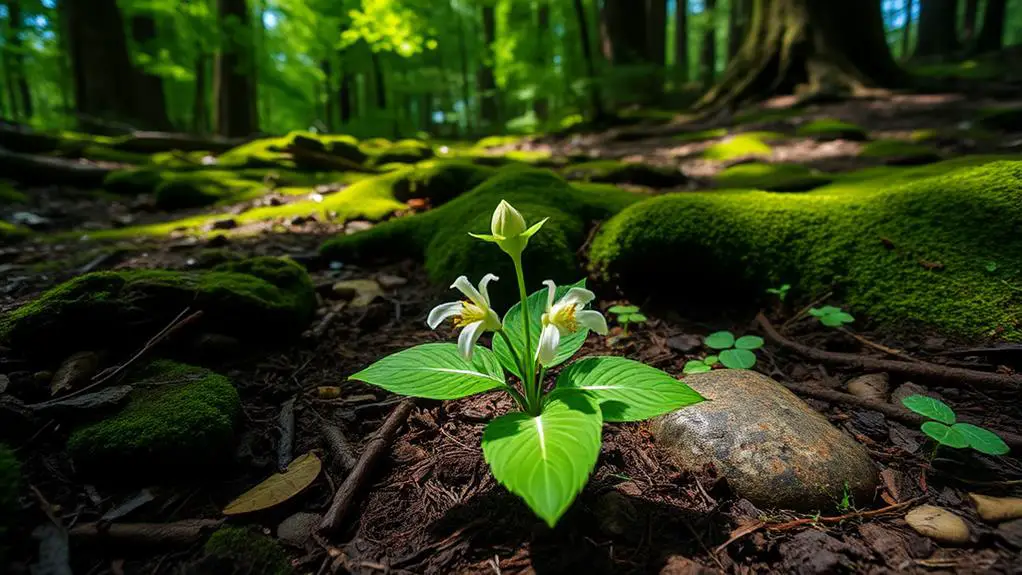
Why is Trillium often considered a challenge even for seasoned gardeners? Trillium, with its striking three-petaled blooms, thrives in rich, moist, well-drained soil and prefers dappled sunlight. This makes it perfect for partly-shaded, deciduous woodland habitats. However, its slow growth rate and sensitivity to environmental changes can test your patience and gardening skills.
Trillium's slow growth rate means it takes several years to establish and bloom. It's important to be patient and give this plant time to settle into its environment. Trillium is also sensitive to environmental changes, such as soil disturbance and compacted ground, which can greatly hinder its growth and flowering. Because of this, it's vital to handle the soil carefully and avoid disturbing the plant once it's been planted.
Here's a quick overview to help you remember key points:
| Requirement | Description | Consideration |
|---|---|---|
| Soil | Rich, moist, well-drained soil | Avoid soil disturbance |
| Sunlight | Dappled sunlight | Ideal for partly-shaded areas |
| Growth Rate | Slow | Patience required for blooming |
Many Trillium species are threatened or endangered due to habitat loss, so cultivating them responsibly is essential for their preservation. By understanding these needs and challenges, you'll be better prepared to grow Trillium successfully.
Gardenia
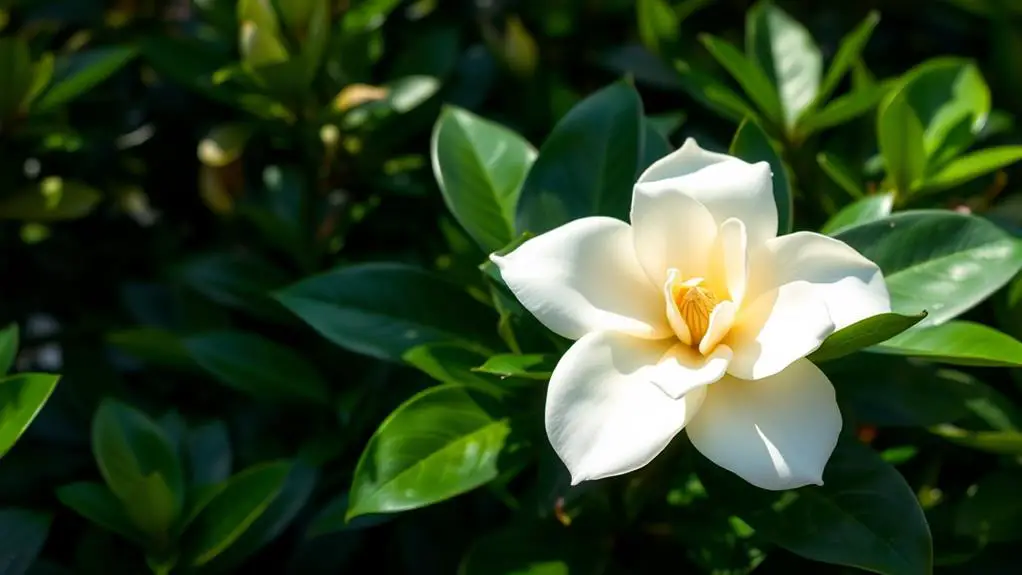
Gardenias, with their fragrant white blossoms, are a beloved yet demanding choice for expert gardeners. These difficult houseplants require a lot of attention and care to thrive.
To start, they need consistently humid conditions and rich, organic soil with a pH between 5 and 6. Gardenias also need their soil to be moist but not waterlogged, which can lead to root rot. You'll need to carefully manage your watering practices to guarantee the right balance.
Temperature control is another critical aspect. Gardenias prefer temperatures between 60-65°F to prevent bud drop. If your home or garden can't maintain this range, you might struggle with keeping these plants happy.
Additionally, they're prone to pests such as aphids and whiteflies, so regular monitoring and management are essential.
Proper pruning is key to maintaining shape and encouraging blooming. This plant can be quite finicky, but with diligent care, you'll be rewarded with beautiful flowers.
Here are some tips to help you succeed:
- Guarantee consistent humidity
- Use rich, organic soil with proper pH
- Carefully manage watering to avoid root rot
- Monitor for pests regularly
With patience and dedication, you can master growing gardenias.
Azalea
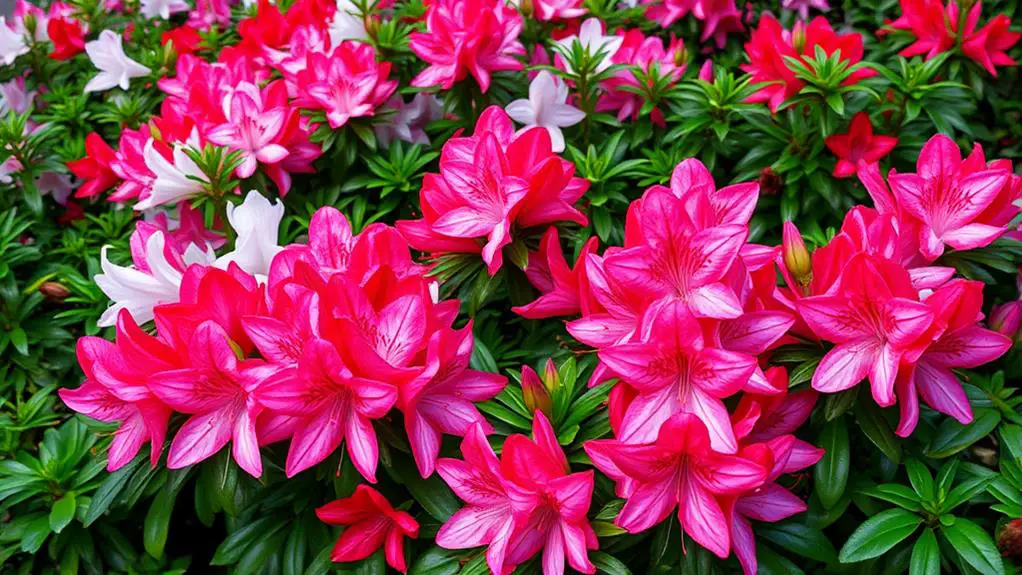
Just as gardenias demand meticulous care, azaleas also pose a challenge for expert gardeners. These beautiful plants need slightly acidic soil, with a pH range between 5.0 and 6.0. To maintain this, you might need to add specific soil amendments.
Finding the right spot in your garden is essential; azaleas flourish in semi-shady locations, ideal for woodland gardens. However, be cautious about placing them in direct sunlight or overly dry areas, as they can struggle in these conditions.
Consistent moisture is key. Azaleas prefer their soil damp but not soggy, which can be a tricky balance. Too much water can lead to root rot and other diseases. Regular watering is vital, especially during dry spells.
Keep an eye out for pests like lace bugs and spider mites. These tiny invaders can cause significant damage, so regular monitoring and prompt action are necessary to keep your azaleas healthy.
While azaleas produce stunning spring blooms, getting them to rebloom indoors can be particularly challenging. Indoor conditions rarely match their ideal outdoor environment.
With careful attention to these details, you can enjoy the vibrant beauty of azaleas in your garden.
Alocasia
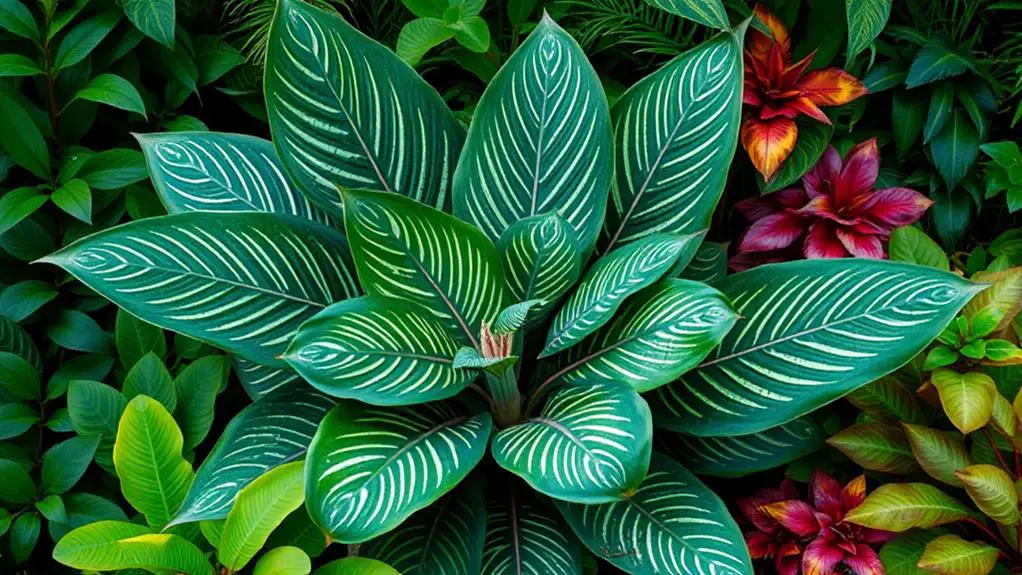
Alocasia, often referred to as elephant ear plants, are a true test for seasoned gardeners. These tropical beauties thrive in warm, humid microclimates and need consistent temperatures between 65-80°F (18-27°C) to grow their best.
But they're not just about warmth; they're incredibly sensitive to drafts and need shaded conditions to prevent leaf burn. It's no wonder they're considered a challenge!
To keep your Alocasia happy, focus on these essentials:
- Humidity: Aim for high humidity, around 60-80%. Frequent misting or a humidifier will be your best friend.
- Well-Draining Soil: Alocasia hates soggy roots. Make sure your soil drains well to prevent root rot.
- Indirect Light: Place your plant in bright, indirect light. Direct sunlight can scorch those delicate leaves.
- Consistent Care: They don't like fluctuating environments, so keep things stable.
Frequently Asked Questions
What Is the Most Difficult Plant to Grow?
You'll find Rafflesia arnoldii to be the most difficult plant to grow. Its parasitic nature and reliance on specific host plants make it nearly impossible to cultivate outside its native tropical habitat, even for expert gardeners.
What Is the Most Difficult Flower to Grow?
You'll find the Ghost Orchid incredibly tough to grow. It demands high humidity and specific light conditions. If you're seeking a real challenge, this elusive bloom will test your skills more than any other flower.
What's the Hardest Houseplant to Keep Alive?
The hardest houseplant to keep alive is the orchid. It needs specific light, humidity, and watering conditions. Without weekly attention and careful monitoring, it can easily suffer from root rot, making it a true challenge for any gardener.
What Is the Hardest Edible Plant to Grow?
You'll find Wasabi to be one of the hardest edible plants to grow. It demands cool, shaded environments and consistently moist, well-drained soil. Mimicking its natural habitat in Japan's riverbeds is a significant challenge for gardeners.
Conclusion
Don't be discouraged if your first attempts at growing these tricky plants don't go perfectly. Remember, even expert gardeners face challenges. With patience and careful attention to soil, humidity, and pest control, you'll improve. Take notes on what works and what doesn't, and don't hesitate to ask for advice from gardening communities. Each plant you successfully nurture is a reflection of your growing skills. Keep learning, stay committed, and you'll see your hard work pay off.

